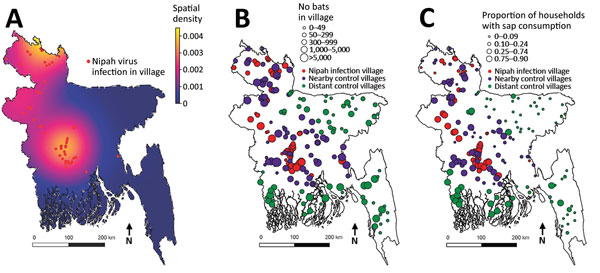Volume 23, Number 9—September 2017
Research
Convergence of Humans, Bats, Trees, and Culture in Nipah Virus Transmission, Bangladesh
Figure 1

Figure 1. A) Locations of identified bat-to-human transmission of Nipah virus and spatial intensity of transmission events, Bangladesh, 2001–2012. B) Relative sizes of the Pteropus medius bat populations in case and control villages (including within 5 km of each village). C) Proportion of households in case and control villages with persons who regularly consume fresh date palm sap.
1Current affiliation: Johns Hopkins Bloomberg School of Public Health, Baltimore, Maryland, USA.
2Current affiliation: University of Michigan School of Public Health, Ann Arbor, Michigan, USA.
3Current affiliation: Medical Research Council, Banjul, The Gambia.
4Current affiliation: University of Florida, Gainesville, Florida, USA.
Page created: August 14, 2017
Page updated: August 14, 2017
Page reviewed: August 14, 2017
The conclusions, findings, and opinions expressed by authors contributing to this journal do not necessarily reflect the official position of the U.S. Department of Health and Human Services, the Public Health Service, the Centers for Disease Control and Prevention, or the authors' affiliated institutions. Use of trade names is for identification only and does not imply endorsement by any of the groups named above.